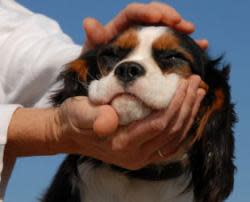DIY: Massage Therapy for Pets
By WebVet.com

Massaging your dog or cat can provide them comfort and health benefits if the massages are done correctly. Courses, manuals, videos - there are plenty of resources for anyone who wants to give a massage to their pet.
Kim Shotola strongly urges pet owners to consult with their vets to make sure massage will be beneficial and not detrimental. "It's very important to know what you can do and what you cannot do," she said. "You never want to do more harm than good. Working with a vet can help minimize problems."
She says that for the most part, massage for a pet involves many of the same techniques used on people, including four basic techniques:
Effleurage - long, slow strokes increase circulation and promote relaxation
Friction - promotes blood flow and prevents adhesions
Percussion - drumming with the fingers or hands
Petrissage - kneading in which the skin is lifted and squeezed.
Shotola recommends placing the animal on a firm but comfortable surface. "The floor is fine; tables are not needed though special tables for pets are now being marketed," she said. "Skip cushions or pillows."
Start with soft, slow strokes from head to tail.
Move to the head. Work various areas of the face using light pressure and using circular motions. Work gently and avoid abrupt movement.
Move to the neck, shoulders, and chest and increase pressure while sustaining circular movements. Gently gather loose folds of skin and stretch (petrissage).
When working on the spine, use the thumb and index finger to trace the length of the spine; however, work the long muscles on each side of the spine instead of directly on the spine.
Don't forget the legs. Use gentle, circular strokes to work up and down.
Finish with the same long, slow strokes that began the massage.
She also notes the importance of knowing what not to do when giving a pet massage:
Don't press too hard, especially on the stomach.
Be careful with sensitive areas, such as ears.
Don't force the massage on the pet. They'll let you know when to proceed and when to finish.
"You must be careful," Shotola said. "For example, owners should never massage an animal that has low blood pressure, fever, poisoning, severe trauma, severe debilitation or pets that have gone into shock. Do not massage hot spots, tumors, infected areas, cuts or abrasions, surgical incisions or areas where the animal shows signs of discomfort or pain."
Pet massage is worth the effort. "It will improve their health and prolong their lives," she said. "Those are pretty good reasons to do it."
Check out more from WebVet:
